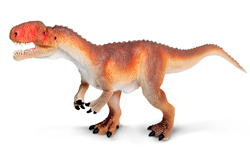 Expanding your retail merchandise always comes with the same set of questions: what do I want to sell next and how do I begin selling those items? In order to assist our readers in reaching their highest selling potential, Independent Retailer has now created a new monthly series entitled Beyond Your Lines. Here we will provide you with the best tips from experts in their selling categories on how to grow your business, what to expect from the merchant, and what they will require from you, to ensure an effective and efficient exchange. Starting us off this month will be Stacie Beavers, Sales Manager at Safari Ltd., who will shed some light on what it takes to begin selling our first category item: toys.
Expanding your retail merchandise always comes with the same set of questions: what do I want to sell next and how do I begin selling those items? In order to assist our readers in reaching their highest selling potential, Independent Retailer has now created a new monthly series entitled Beyond Your Lines. Here we will provide you with the best tips from experts in their selling categories on how to grow your business, what to expect from the merchant, and what they will require from you, to ensure an effective and efficient exchange. Starting us off this month will be Stacie Beavers, Sales Manager at Safari Ltd., who will shed some light on what it takes to begin selling our first category item: toys.
Getting Started:
The topic of toys may seem broad, but this way it will give you a chance to really think about what kinds of toys should be sold at your specific store. From figurines and stuffed animals, to collectables and games, the category of toys is not a simple one. So, with the help of our expert, the must know information on selling toys will be right at your fingertips. There are several ways of going about purchasing new merchandise, but take into account these tips while growing your store.
It is most important to do research before diving into selling new lines. The first step, said Beavers, is contacting neighboring toy companies in your area to see what are their must have products.
“Start with the best sellers. Once you have a small amount selling in your store, then be sure to keep in touch with customers and see what comments they have about your selection,” said Beavers. “Start with what you think works best for you.”
 When trying to decide what to sell, keep in mind some broad themes that most kids might enjoy. Wildlife and Dinosaurs, safari animals and dogs, as well as board games and cards are among the most popular toy categories and themes that appeal to all kids. Once you decide exactly what you want to sell and you’ve done research on what would work best for your store, now it is time to find the right supplier. This is one of the most crucial of decisions, because finding the best supplier will have a lot to do with the success of your new merchandise. As with any other supplier you have, you will need one that cares about your business and will not just try to push product on you.
When trying to decide what to sell, keep in mind some broad themes that most kids might enjoy. Wildlife and Dinosaurs, safari animals and dogs, as well as board games and cards are among the most popular toy categories and themes that appeal to all kids. Once you decide exactly what you want to sell and you’ve done research on what would work best for your store, now it is time to find the right supplier. This is one of the most crucial of decisions, because finding the best supplier will have a lot to do with the success of your new merchandise. As with any other supplier you have, you will need one that cares about your business and will not just try to push product on you.
“Here at Safari we call our sales reps Toy Gurus because they know everything about the toy industry and market,” said Beavers. “They take the time to have a conversation with you on what will work best for your store, and create a working relationship with you over time.”
One should not be wary of asking their suppliers questions because they are supposed to be there to help your business, said Beavers. Even when returns are a concern, suppliers should understand that mistakes happen and not every product will work for every store. “At Safari we want to make sure our buyers are happy, so there is always a solution to be found when we come across an issue. This is why we have the Toy Gurus,” said Beavers, “because they make sure to ask the right questions and offer advice. This way we can rectify any problems buyers might have immediately, and do what is best for you and your company.”
Mistakes to Avoid:
There will always be popular mistakes and misconceptions retailers have when upsizing their merchandise. Here are a few to avoid and ways to correct them.
The age group of your audience is not always key. A common misconception of toy selling is that the audience will be only toddlers and children, but there is actually a much larger audience in which to cater. “We have so many people that use our toys for educational purposes, as wedding favors, as part of DIY projects, or are just collectors that are well into their thirty’s,” said Beavers. “Even if your audience is only children, the parents are the ones buying the merchandise. Something needs to appeal to them so they know their child can enjoy, play, and learn with those toys.”
Other misconceptions when selling toys are that the buyer is fearful that they will sell the wrong merchandise. The biggest tip for this is to make sure you work with a supplier that is knowledgeable about different types of stores and can offer the best products for your vision – a company that can be reliable and patient. New buyers may also find some trouble when placing orders, so making sure you account for what you need most in your store is vital. Some retailers are so busy putting in orders of what they think they need, said Beavers, they overlook the products that are really working for them.
Keep In Mind:
Now that we have provided the tools and expertise on the toy industry, it is up to you, the retailer, to go out and decide if this is the right merchandising step for you. Remember these tips when on your journey to retail growth.
• Find your target audience: devote time to researching what will work best in your store and for your location
• Understand that there will be some products that work for you, and some that don’t sell as well
• Be willing to switch out items and try different toys in your store
• Remember seasonality: keep track of your busiest seasons and products and share that with your supplier to ensure your store is always in stock and keeping busy
• Looks are everything: make sure you display your merchandise correctly. Use fixtures, graphics and themes to draw your customers in and keep your products organized
